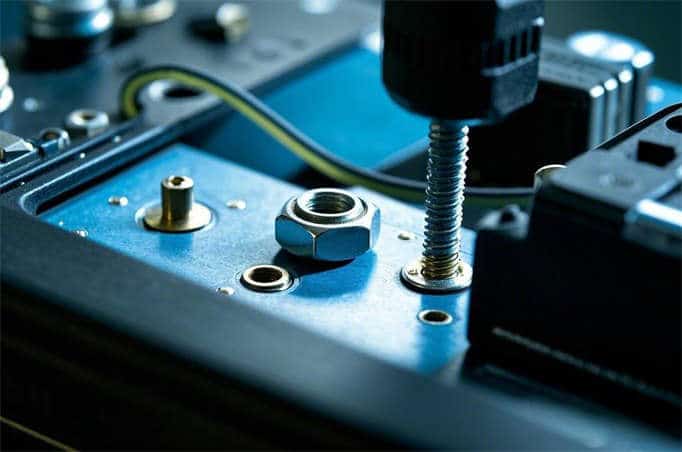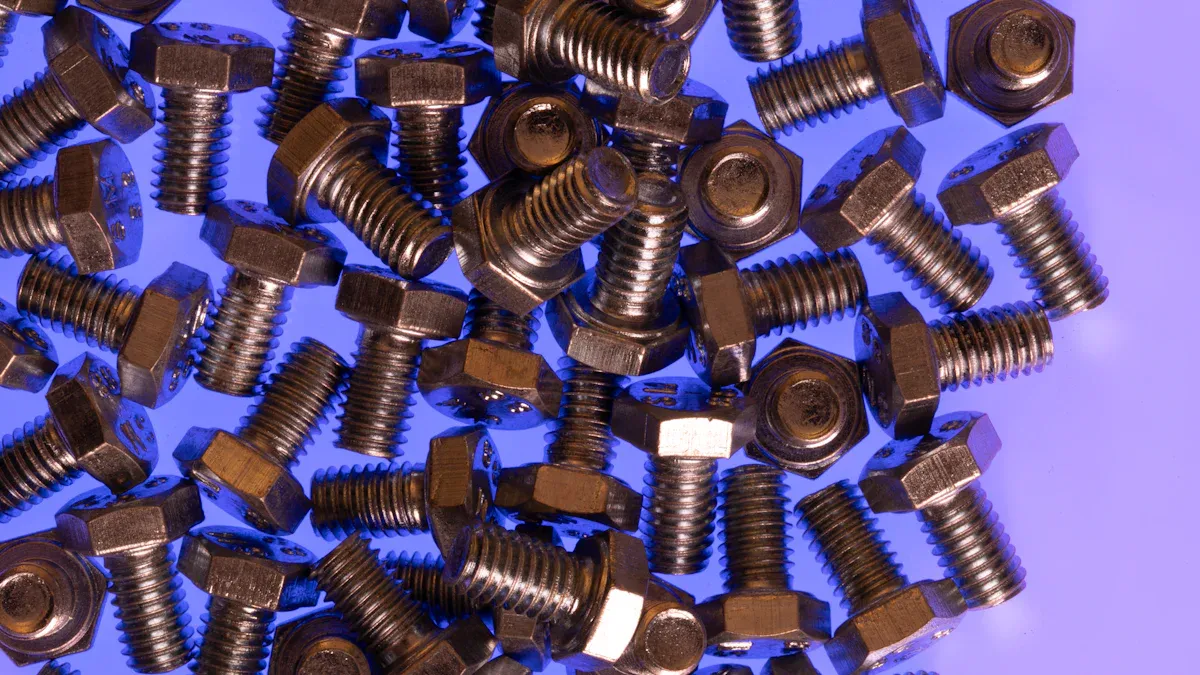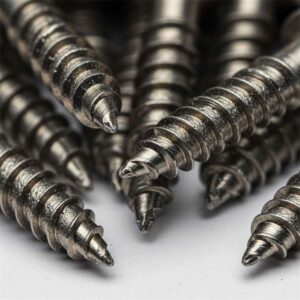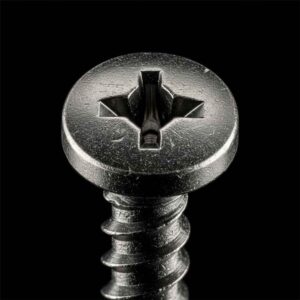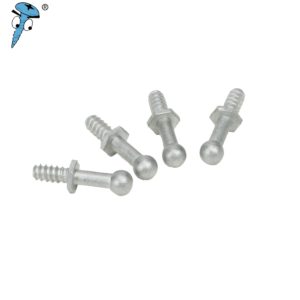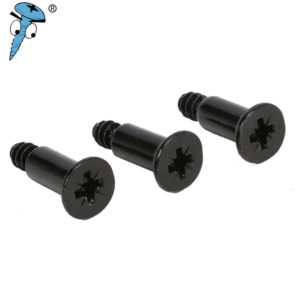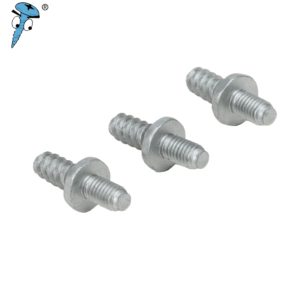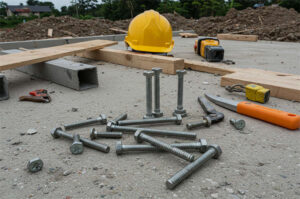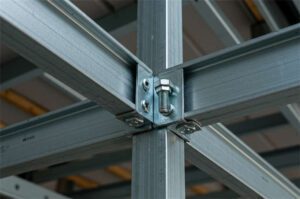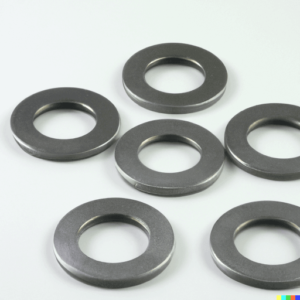If you want the safest option for high-stress or critical uses, you should choose a castle nut. This nut gives you strong locking power and keeps important parts secure. You often see it in places like suspension systems, steering parts, and engine mounts. A slotted nut works better for general tasks and gives you more flexibility. You find these nuts on machinery, farm equipment, and bicycles. The right choice depends on what you need to fasten and how much security you require.
Основные выводы
Выберите castle nut for tough jobs. It holds parts tight and safe. This makes it good for cars and big machines.
Use a slotted nut for simple jobs. You can put it on and take it off easily. It works well for quick repairs and normal use.
Всегда pick the right nut for your project. Think about how much weight and shaking there will be. This helps keep things safe and working well.
Always use a cotter pin with both nuts. The pin stops the nut from coming loose. It also makes things safer.
Look for damage before you use them. Check the nut and pin so you do not have problems when you put them on.
Quick Comparison

Castle Nut Overview
Вы часто видите castle nut in places where safety matters most. This nut has a tall shape with notches cut into the top. The notches look like the walls of a castle, which gives the nut its name. You use a castle nut when you need to lock a bolt in place. You slide a cotter pin through the notches and a hole in the bolt. This keeps the nut from turning or coming loose. You find castle nuts on car suspension systems, steering linkages, and heavy machinery.
Совет: If you want extra security for moving parts, choose a castle nut.
Key features of a castle nut:
Tall body with deep notches
Uses a cotter pin for locking
Handles high stress and vibration
Common in automotive and industrial settings
Особенность | Замок Орех |
|---|---|
Shape | Tall, notched top |
Locking Method | Cotter pin |
Лучшее применение | Safety-critical |
Slotted Nut Overview
You use a slotted nut for many general tasks. This nut has slots cut into a flat top. The slots let you insert a cotter pin, but the nut sits lower than a castle nut. You find slotted nuts on farm equipment, bicycles, and light machinery. You can install and remove a slotted nut quickly.
Примечание: If you want a nut for everyday jobs, a slotted nut gives you flexibility.
Key features of a slotted nut:
Flat top with straight slots
Cotter pin fits through slots
Easy to install and remove
Good for light to medium loads
Особенность | Slotted Nut |
|---|---|
Shape | Flat, slotted top |
Locking Method | Cotter pin |
Лучшее применение | General purpose |
Ключевые различия
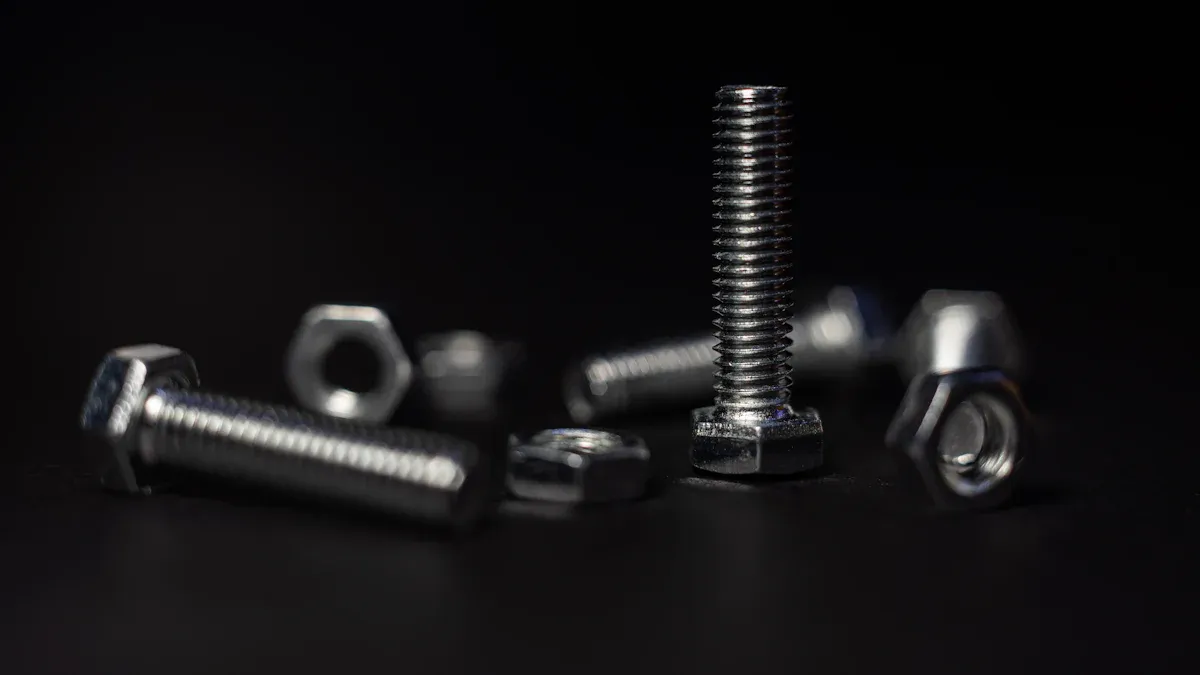
Design & Structure
When you look at a castle nut, you notice its tall, turret-like top. This design stands out because it has a hexagonal base and a raised section with deep slots. These slots let you insert a cotter pin for extra security. The taller profile gives the nut more strength and helps it stay locked in place. Here is a quick table to help you see the main features:
Особенность | |
|---|---|
Shape and Structure | Hexagonal base with a raised turret-like top section featuring slots. |
Slot Design | Slots cut into the turret allow for a cotter pin to secure the nut tightly. |
Height and Profile | Taller design provides a robust locking mechanism, enhancing security against loosening. |
A slotted nut looks different. You see a flat top with straight slots cut into it. The nut sits lower on the bolt, which makes it easier to use in tight spaces. The slots still let you use a cotter pin, but the nut does not have the extra height or turret shape. This makes the slotted nut better for general jobs where you do not need as much locking power.
Locking Mechanism
The locking mechanism is the most important part of both nuts. You use a cotter pin or safety wire to keep the nut from turning. With a castle nut, the slots in the turret line up with a hole in the bolt. You push the cotter pin through, and the tall sides of the nut protect the pin. This design keeps the pin from sticking out and getting damaged. The locking mechanism in a castle nut works very well in places with lots of vibration, like cars or airplanes.
A slotted nut uses a similar locking mechanism. You put a cotter pin through the slots and the bolt. The difference is that the pin sits more exposed because the nut does not have a turret. This makes the locking mechanism less secure in high-vibration areas. The pin can bend or wear out faster. Here is a table to show how the locking mechanism works in a castle nut:
Особенность | Описание |
|---|---|
Тип | Castle nuts are a type of lock nut. |
Locking Mechanism | Utilize slots or notches for cotter pin or safety wire. |
Effectiveness | Effective in preventing loosening under vibration. |
Приложения | Suitable for automotive and aerospace industries. |
You should remember that both nuts lock in place, but the castle nut gives you better protection for the pin and more security.
Strength & Security
You want a nut that will not come loose when it matters most. The castle nut gives you this strength because of its tall design and strong locking mechanism. The extra height lets you use a thicker cotter pin, which holds the nut tight even when the bolt shakes or moves. You often see castle nuts in car suspensions, steering systems, and heavy equipment. These places need the best security.
A slotted nut works well for lighter jobs. You find it on bicycles, farm tools, and small machines. The locking mechanism still works, but it does not protect the pin as much. If you use a slotted nut in a high-stress spot, the pin might bend or break. You should use a slotted nut when you do not need the highest level of security.
You also need to think about коррозионная стойкость. Castle nuts come in steel, stainless steel, or brass. They often have finishes like zinc plating or black oxide to fight rust. Slotted nuts use premium stainless steel alloys, which give them even better resistance to corrosion. Here is a table to compare:
Nut Type | Materials Available | Corrosion Resistance Properties |
|---|---|---|
Castle Nuts | Steel, Stainless Steel, Brass | Enhanced by finishes like zinc plating or black oxide |
Slotted Nuts | Stainless Steel (A2, A4) | Superior corrosion resistance due to premium alloys |
Installation & Removal
You need the right tools to install or remove these nuts. For a castle nut, you use a wrench, a cotter pin, and a bolt with a hole drilled through it. The process takes a little more time because you must line up the slots with the hole and insert the pin. This extra step gives you more security.
A slotted nut is easier to install and remove. You still use a wrench and a cotter pin, but the flat top makes it simpler to handle. You do not have to worry as much about lining up the slots. This makes the slotted nut a good choice for quick repairs or jobs where you need to take the nut off often.
Tip: If you need to save time or work in a tight space, pick a slotted nut. If you want the best locking mechanism for safety, choose a castle nut.
Choosing the Right Nut
Castle Nut Applications
You use a castle nut for jobs that need extra safety. This nut locks parts tightly, even when they shake or move a lot. You see castle nuts where it is very important that nothing fails. Car makers and machine builders pick this nut for tough jobs.
Machinery/Vehicle Type | Описание |
|---|---|
Автомобильный | Used in cars to keep parts from moving or coming loose. |
Машины | Used in machines where strong locking is needed because of heavy use. |
Castle nuts are also used in many industries. These include aerospace, aviation, construction, electronics, marine, military, oil and gas, railway, and telecommunications. These jobs need the best security for moving parts. You find castle nuts in suspension systems, steering linkages, and engine mounts. These are places where safety is very important.
Tip: Pick a castle nut for heavy loads, lots of movement, or strict safety rules.
Slotted Nut Uses
You use a slotted nut for many everyday jobs. This nut works well in building, fixing, and repair work. You see it in things like HVAC systems, conveyor belts, pump assemblies, and building projects. The slotted nut is flexible and saves time when you put it on or take it off.
Construction: Slotted nuts hold parts together in buildings where strong fastening is needed.
HVAC Systems: These nuts keep parts in heating and cooling systems secure.
Conveyor Belts: You use slotted nuts to adjust and line up belts.
Pump Assemblies: Slotted nuts hold pump parts that shake or move.
Slotted nuts are easy to put on and take off. You can use a screwdriver, which makes work faster and cheaper. The nut grips bolts tightly so they do not come loose when things shake. Stainless steel slotted nuts do not rust, so they work well outside or in wet places. You find slotted nuts where you need flexibility and protection from rust.
Note: Use a slotted nut for quick fixes, easy changes, or tight spaces.
Ошибки, которых следует избегать
You should not make распространённые ошибки when picking or using these nuts. Castle nuts and slotted nuts do not let you set torque exactly. This can make the parts too loose or too tight, which is not safe. You need split pins or other parts to lock these nuts, which makes the job harder. Lining up the nut for the pin takes time and can slow down your work.
Mistake Type | Описание |
|---|---|
Inability to fine-tune torque | You cannot set the tightness exactly, which can make the nut too loose or too tight. |
Requirement for additional components | You need extra parts like split pins to lock these nuts, which makes assembly harder. |
Alignment time | Lining up the nut for the pin takes extra time and can delay your project. |
If you do not tighten castle nuts right, bearings can wear out too soon. If you tighten them too much, spindles and bearings can get too hot and break. Always follow the steps for putting the nut on and check that everything lines up before you add the pin.
Alert: Always check how tight the nut is and make sure it lines up before you lock it. This helps you avoid expensive repairs and keeps your project safe.
Expert Advice
Decision Tips
When you pick a castle nut or a slotted nut, you should think about more than just how it looks. Experts say you need to check the locking method, the design, and if the nut fits your project. Castle nuts have a turret end that bends down a little. This lets you wrap a split pin around and lock it tight. Slotted nuts do not let you do this, so they are not as safe in places that shake a lot.
Here is a table that shows what experts say matters most:
Особенность | Замок Орех | Slotted Nut |
|---|---|---|
Дизайн | Turret end section turned down slightly | Turret end section not turned down |
Locking Mechanism | Allows split pin to be wound round and pinned | Does not allow for this |
Диаметр | Castellated section smaller than main section | Castellated section same as main section |
Общее использование | Often used as axle nuts | Used in various applications |
You should always check how strong the nut needs to be. If your project has heavy loads or lots of shaking, a castle nut is better than a regular nut. You also need to think about rust. For outdoor jobs, stainless steel or hot-dip galvanized nuts last longer than regular nuts. Using good, certified fasteners helps you follow safety rules and keeps your work safe.
Tip: Pick the nut that matches your job and how much weight or shaking it will face. Do not use a regular nut when safety is very important.
Quick Checklist
You want to make sure you choose the right nut and put it on the right way. Engineers use a checklist to help avoid mistakes. Follow these steps for the best results:
Check how much weight and strength you need.
Pick a nut with the right locking method for your job.
Use stainless steel or galvanized nuts outside or in wet places.
Make sure the nut fits the bolt size and thread.
Use a castle nut for tough or important jobs.
Use a slotted nut for simple tasks or quick fixes.
Never swap a castle nut for a regular nut in important spots.
Always use a split pin or cotter pin to lock the nut.
Look at the nut and pin for damage before you use them.
Tighten the nut to the right level, then line up the slot for the pin.
Here is a table of common nut types you might see:
Nut Type | Описание |
|---|---|
Соединительные гайки | Used to connect two pieces of threaded rod. |
Фланцевые гайки | Feature a wide flange to spread out force and stop loosening. |
Шестигранные гайки | Have six sides and are easy to tighten. |
Стопорные гайки | Made to stay tight even when things shake. |
Шлицевые гайки | Have a slot for a screwdriver, so you can put them on easily. |
Квадратные гайки | Have a big surface for better grip. |
Wheel nuts | Made to hold wheels in place. |
Additional types | Include special nuts for different jobs. |
Note: Always use the right nut for your project. A regular nut may look easy, but it does not keep things as safe as a castle nut or slotted nut.
You see new styles of castle nuts and slotted nuts in jobs like oil and gas, transportation, and building. These new nuts help keep bearings safe and stop shaking better than regular nuts. Castellated nuts use notches to hold pins tighter, while slotted nuts are good for quick and easy use.
If you want the safest choice for critical jobs, you should pick a castle nut. Castle nuts give you strong locking and protect moving parts. Slotted nuts work better for quick fixes and general tasks. You need to match the nut to your project and safety needs.
Remember: Castle nuts offer more security. Slotted nuts give you flexibility.
Quick Checklist:
Check load and vibration level.
Choose the right locking method.
Use stainless steel for outdoor jobs.
Always use a cotter pin for safety.
Часто задаваемые вопросы
What is the main difference between a castle nut and a slotted nut?
You see a castle nut with a tall, notched top. A slotted nut has a flat top with straight slots. Castle nuts give you more security for high-stress jobs.
Can you use a slotted nut instead of a castle nut?
You should not swap a slotted nut for a castle nut in safety-critical places. Castle nuts protect moving parts better. Use slotted nuts for light or general tasks.
How do you lock a castle nut or slotted nut?
You insert a cotter pin through the slots and the hole in the bolt. This pin keeps the nut from turning or coming loose. Always check the pin before use.
Where do you find castle nuts most often?
You find castle nuts in car suspensions, steering systems, and heavy machinery. These nuts work best where safety and strong locking matter most.
What tools do you need to install these nuts?
You need a wrench and a cotter pin. For castle nuts, you also need a bolt with a hole for the pin. Slotted nuts install faster and work well for quick repairs.
